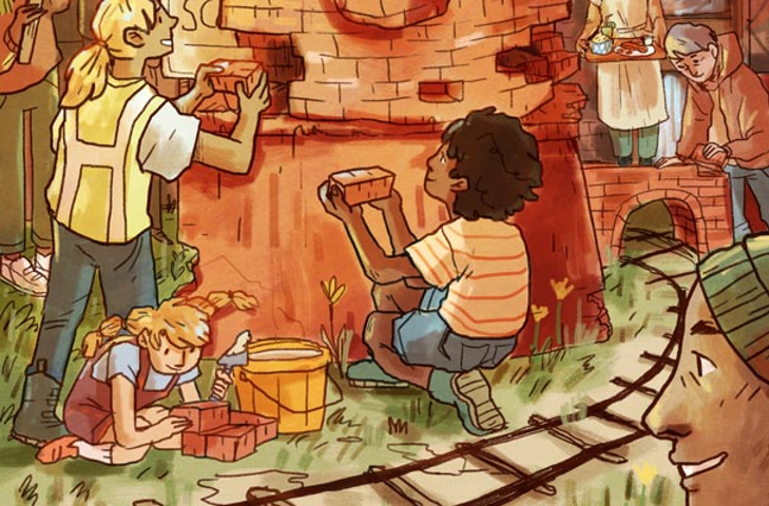‘A great brand, company, city, community – is a story that never stops unfolding’, announced Tony Hsieh in 2009. The Zappos CEO was speaking about his Downtown Project in Las Vegas, the self-described coworking capital of the world, which has a mission to ‘empower people to follow their passions to create a vibrant, connected urban core’. Since then renovations have turned the old urban fabric into coworking hubs and sharing spaces. The whole place is now set up with WiFi, and there is an outdoor mall constructed from shipping containers, all for a new community of entrepreneurs to bring about transformative change.
The idea of running a city like a startup has not taken off and the £350m investment was quickly spent. Five years into the ambitious plan, projects had to be cut and the company faced massive layoffs. Nonetheless, Hsieh’s dream of a startup community capital was impactful and enhanced a growing trend. Almost ten years later the value of ‘community’ has become an integral element of mainstream economic practice. A majority of coworking spaces promote their inclusive community as a core selling point and employ at least one Community Organiser to build connections and to develop work opportunities between freelancers. Alongside hosting events, many of London’s Huckletree or WeWork communities feature game nights, yoga on the rooftop terrace and, of course, beer from the tap.
However, a few streets further down from Hackney’s WeWork complex you will encounter some of London’s most disadvantaged neighbourhoods with the highest rates of child mortality. San Francisco, another candidate in the race to become top global innovation hub, leads US figures in income gaps and housing costs. It is evident that gentrification benefits primarily flow to more skilled, educated workers, whereas existing communities are increasingly priced out of their neighbourhoods.
So if new and repurposed workspaces seem to reinforce inequality and exclusion, what hope is there, if any, for coworking spaces to be part of a movement for social change? As practitioners who are working in this sector, how do we respond? This article calls for ‘community’ to be led back to its origins and to defend the values that social justice organisers have fought for throughout history. It explains the problematic exclusivity of coworking communities’ support structures, and suggests some recommendations for how we can base new economic practices on solidarity.
Community organising per definition
In light of its popular use, it is helpful to examine definitions of community organising outside of the social innovation bubble. The term itself refers to a form of organisation building that emerged in the US after the Second World War. In its most traditional form, community organising involves the building of membership organisations, which can include institutions with existing memberships such as churches and labour unions, and at other times is made up of families and individuals.
Throughout history community organisations have achieved major victories with legislative changes, expansion of social services and educational access, such as the Civil Rights Act or the introduction of the Living Wage. In Nassau county, US, the Workplace Project led by Latino immigrant workers helped pass the Domestic Workers Bill of Rights. In India, the Self-employed Women’s Association successfully campaigned in the face of police harassment, leading to vending licenses and reserved spots in markets for informal workers. Community Organising has grown into a profession with its own body of research and globally spread training institutes, reaching from yiaga Africa in Nigeria and the Centre for Third World Organising in the US, to the New Economy Organisers Network in Great Britain.
At its core, the act of community organisation stands in direct relationship with an oppressive institution of power and is based on solidarity and mutual aid. Some of the most significant campaigns in the history of community organising were built through solidarity coalitions. Women Against Pit Closures was a political movement during the Miners’ Strike of 1984-5 and supported miners, their families, and wider communities. The women fundraised, marched, and organised events, and was one of the main reasons the strike was able to continue for so long. In 2015, Black Lives Matter and the Afro-Colombian Solidarity Network formed a joint campaign in support of communities in Cauca, Colombia to protect their land in the face of oppression by militia groups and multinational mining corporations.
Particularly within neighbourhood organising, coalition building has formed a key historic strategy. One of the most prominent examples is the Back of the Yards Neighbourhood Council, set up in 1930s Chicago. In a predominantly Irish-Catholic community, the Neighbourhood Council successfully united previously hostile ethnic groups of Serbs and Croatians, Czechs and Slovaks, Poles and Lithuanians, and formed the first US alliance between the Catholic Church and Left-wing unions. Its work led to improved access to medical health care, a community fund for the neighbourhood, and the creation of a school lunch programme that became a model for the nation. If we compare these ideas of community with the social reality of most coworking freelancers, there seems to be an apparent contrast.
Future of work & the gig economy
According to a recent report by Co-operatives UK, there are now more people in self-employment than ever before, and by the end of 2018 the number of self-employed is expected to exceed public sector employees. The precarious experience of self-employed workers is reflective of complex and diverse patterns of atypical work, ranging from casual work to temporary jobs. As a freelancer in the UK economy you can expect unpaid invoices, zero-hour contracts, the absence of workplace insurance, pension, and sick pay. Many self-employed workers, especially those that are desk-based, are often isolated. This has significant effects on their wellbeing and workplace protections, and these consequences have led to a new demand for coworking spaces where people can experience social interaction. If managed well, these spaces can enable new collaborations for individuals and teams.
So if the practice of community seems to counter the negative effects of the gig economy, then what exactly is the problem? Taking a look at the demographics within the statistical analysis of the gig economy starts to paint a different picture. According to the tuc, non-white workers are about a third more likely to be on temporary or zero-hour contracts than white workers. A study by Heyes and Hastings, supported by the European Platform of Undeclared Work, found that temporary contracts are most likely to affect workers who are younger, foreign-born, or with a low educational attainment. From a gender perspective, involuntary part-time work affects twice as many women as men. At the same time, the results of DeskMag 2017 Global Coworking Survey have shown that members within coworking spaces were predominantly white and male, over 80% had completed a bachelor’s degree, and if measured on their income would classify as part of the middle or upper class. In light of these figures, it is fair to assume that the current support structures for coworking freelancers fail to reach those most affected by precarious work.
This makes the self-styled culture of social entrepreneurship ever so more problematic, particularly the illusion that it will be their next digital disruption, funded by the next glorified investor, which will spread wealth and wellbeing for everyone. Having discovered the value of community, it seems the benefits have been exclusive to a selected few and the rest of the population have been left to deal with the setbacks of a changing economy.
For coworking spaces to play a part in a movement for equality, these spaces need to genuinely engage with the structural injustices that characterise their local context, or they’ll only keep recreating artificial subcommunities. Instead of appropriating community as a commodity, sold as part of a package deal, community organisers need to encourage participation and ownership.
The right to participate
In practical terms, what does this mean? What can we do as practitioners if private development and gentrification seem inevitable? To be relevant ‘community’ needs to involve a diverse range of members, start identifying barriers to participation, and ensure that these spaces are accessible and can sustain each member during difficult times. It involves planning around the social reproduction needs of our members, like Mother House Studio in London and L’Alveare in Rome, where childcare services are integrated into their workspaces. Increasing participation also includes questions about pricing structure, outreach and appeal to different groups. Practitioners need to ask themselves who will be able to regularly sip a Colombian roast flat white for £2.80, or rent their meeting rooms for £200 per hour?
In Lambeth, South London, the Brixton Pound Café runs on a pay-as-you-feel basis. Both Impact Hub Birmingham and Brixton make free space available during weekly Open Project Nights. Designing for different income levels has enabled the latter to establish partnerships with new groups in the borough, including the Rastafari Movement and the Diaspora Support Network. Creating business models for coworking spaces that are both social and financially sustainable is challenging, and often highly dependent on rents and business rates. In the face of extortionate housing prices, meanwhile spaces have been instrumental in supporting the growth of community businesses across London.
Nonetheless, these solutions are temporary and come with a high level of insecurity to any carefully built community relationships, which are threatened as soon as developers take over the land. This calls for a more general shift in policy making towards rent caps or rent reliefs for community-use zones. It also highlights the important role that Community Land Trusts play in ensuring that assets are managed and owned by the local community.
The success of locally rooted coworking spaces is also highly dependent on support and partnerships with local authorities, demonstrated by The Participatory City Project in Barking and Dagenham. This ambitious project involves £1.5m in funding by local government and a further £850,000 investment from the Mayor of London. The Warehouse, a newly built coworking space, will be an open access makerspace and free for the borough’s residents. Without trying to limit the importance of getting new participants through the doors of established coworking spaces, a practitioner’s vision must go beyond increased participation and involve a new distribution of power.
You can’t transform the economy, without transforming society
What would it look like if women designed financial services? What if coworking spaces were owned and run by BME communities? Last month the news platform Medium published a list of Black-owned coworking spaces in the US, including An Office in Detroit, ran by the entrepreneur Katrina Turnbow. In London, the Women’s Budget Group, a network of feminist economists, critically analyses UK government spending and makes recommendations from a gender perspective.
For a practitioner, it is important to realise that there will never be a one-size-fits-all version of community organising because the effects of any action are, to a great extent, determined by an organiser’s background, gender, race, and class. The limitations of their impact start and end with the depth of their lived experience, and the type and intensity of the social and political oppressions they have faced themselves. We would never, for example, expect a man to be the face of the Suffragettes movement. In the same way, a community space in a gentrifying neighbourhood that is designed, built and managed by white middle-class workers will only get so far in creating more equal opportunities. Instead of trying to tick the diversity box, we must build effective partnerships with local organisations that are truly empowering, and ensure that community organising remains political instead of becoming an act of charity.
Rather than focusing on specific end goals, we need to put our energy into the way relationships are built and managed throughout the process of our community projects. It is time to put our collective efforts into this and get it right. Let us put an end to the appropriation of community and start designing alternatives to neoliberalism that work for everyone.





